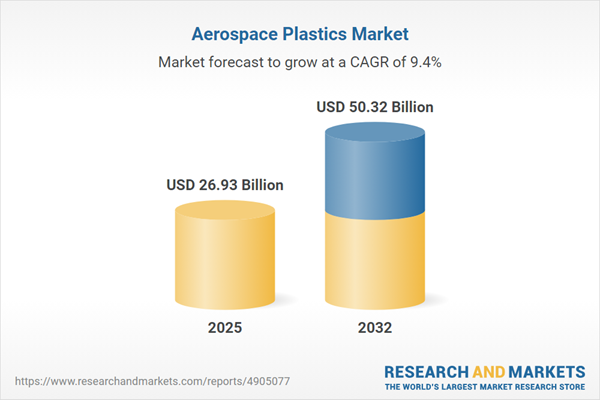Speak directly to the analyst to clarify any post sales queries you may have.
The aerospace plastics market is undergoing significant transformation, as material innovation and regulatory demands drive adoption of advanced polymers across aircraft manufacturing and maintenance. Senior leaders seeking actionable insights into evolving trends, sustainability standards, and strategic opportunities will find this detailed report essential for informed business decisions.
Market Snapshot: Aerospace Plastics Growth Trajectory
The aerospace plastics market grew from USD 24.58 billion in 2024 to USD 26.93 billion in 2025, with expectations of reaching USD 50.32 billion by 2032 at a CAGR of 9.36%. This robust expansion reflects the sector’s response to rising demand for lighter, more durable, and regulatory-compliant components within commercial and defense aviation. As industry participants invest in sustainable polymers and advanced composite solutions, global supply chains and competitive landscapes continue to evolve.
Scope & Segmentation of the Aerospace Plastics Market
This market research delineates the aerospace plastics sector by key materials, processes, application areas, end-user segments, and geographic regions:
- Material Types: Thermoplastics such as PEEK, PEI, Polyamide, PPS; Thermosetting Plastics including Epoxy, Phenolic, and Unsaturated Polyester.
- Manufacturing Processes: 3D Printing, Compression Molding, Extrusion Molding, Injection Molding, Thermoforming.
- Applications: Avionics and Electrical Components, Engine Components, Exterior Components, Interior Components, Structural Components.
- End Users: MRO (Maintenance, Repair, and Overhaul), OEM (Original Equipment Manufacturer).
- Regions: Americas (North America, Latin America), Europe, Middle East & Africa, Asia-Pacific, with in-depth analysis of nations such as the United States, Germany, China, and others.
- Leading Companies: Solvay S.A., Saudi Basic Industries Corporation, Arkema S.A., Evonik Industries AG, DuPont de Nemours, Inc., BASF SE, Mitsubishi Chemical Corporation, Celanese Corporation, Victrex plc, Ensinger GmbH.
Key Takeaways for Aerospace Plastics Decision-Makers
- Material innovation is central, with high-temperature thermoplastics and bio-derived polymers gaining traction due to regulatory and sustainability imperatives.
- Digitization and the integration of additive manufacturing accelerate product development, support design complexity, and enable rapid adaptation to evolving aircraft programs.
- Hybrid composite technologies offer advances in thermal stability and impact resistance, supporting the use of plastics in structural and high-temperature engine applications.
- Strategic partnerships—especially between resin producers, OEMs, and MROs—are strengthening competitive positions and facilitating entry into emerging markets.
- Aftermarket services are expanding, with MRO specialists now offering advanced repair solutions using specialty resins, reducing aircraft downtime and total lifecycle costs.
- Regional growth drivers vary: established markets focus on compliance and sustainability, while Asia-Pacific is propelled by rising aircraft demand and manufacturing capacity buildups.
Evaluating Tariff Impact on Aerospace Plastics
Recent United States tariff measures have introduced new cost calculations and supply chain strategies for aerospace plastics. These tariffs have accelerated the move toward domestic resin sourcing and increased collaboration with North American material partners. Companies are reconfiguring logistics strategies, considering trade-offs between material costs and supply chain security, and integrating tariff implications into design and procurement decisions. This creates both operational risks and potential avenues for innovation in material selection and sourcing strategies.
Methodology & Data Sources
This research applies a rigorous methodology combining direct interviews with aerospace OEMs, tier suppliers, MROs, and resin manufacturers, as well as comprehensive analysis of technical journals, industry standards, and patent filings. All insights are substantiated through data triangulation and expert panel reviews to ensure accuracy and relevance for executive decision-making.
The Role of Aerospace Plastics Market Research
This report enables leaders to:
- Identify high-potential materials and manufacturing technologies for new product development and retrofits.
- Benchmark supply chain resilience and optimize sourcing strategies in response to market volatility and global regulatory shifts.
- Enhance competitive positioning through insights into sustainability practices, digital manufacturing adoption, and key partnership opportunities.
Conclusion
Aerospace plastics remain integral to innovation, cost management, and sustainability in the evolving aviation sector. Stakeholders equipped with these market insights are positioned to anticipate trends, secure supply resilience, and make informed investment decisions in an increasingly dynamic landscape.
Additional Product Information:
- Purchase of this report includes 1 year online access with quarterly updates.
- This report can be updated on request. Please contact our Customer Experience team using the Ask a Question widget on our website.
Table of Contents
3. Executive Summary
4. Market Overview
7. Cumulative Impact of Artificial Intelligence 2025
Companies Mentioned
The companies profiled in this Aerospace Plastics market report include:- Solvay S.A.
- Saudi Basic Industries Corporation
- Arkema S.A.
- Evonik Industries AG
- DuPont de Nemours, Inc.
- BASF SE
- Mitsubishi Chemical Corporation
- Celanese Corporation
- Victrex plc
- Ensinger GmbH
Table Information
| Report Attribute | Details |
|---|---|
| No. of Pages | 192 |
| Published | October 2025 |
| Forecast Period | 2025 - 2032 |
| Estimated Market Value ( USD | $ 26.93 Billion |
| Forecasted Market Value ( USD | $ 50.32 Billion |
| Compound Annual Growth Rate | 9.3% |
| Regions Covered | Global |
| No. of Companies Mentioned | 11 |









